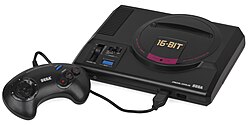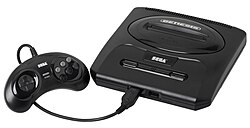Sega Mega Drive
 |
|
|
Top: Original Japanese Mega Drive
Bottom: Sega Genesis Model 2 Other variations are pictured under Variations below |
|
| Manufacturer | Sega |
|---|---|
| Type | Home video game console |
| Generation | Fourth generation |
| Release date | |
| Retail availability | 1988 – present
|
| Discontinued |
|
| Units sold | Sega: 30.75 million Tec Toy: 3 million Majesco: 1.5 million (projected) |
| Media | ROM cartridge |
| CPU |
Motorola 68000 @ 7.6 MHz Zilog Z80 @ 3.58 MHz |
| Display | Progressive: 320x224 (NTSC) or 320x240 (PAL) pixels, 512 color palette, 61 colors on-screen Interlaced: 320x448 (NTSC) or 320x480 (PAL) |
| Sound |
Yamaha YM2612 Texas Instruments SN76489 |
| Online services | Sega Meganet, Sega Channel, XBAND |
| Best-selling game | Sonic the Hedgehog, 15 million |
| Backward compatibility |
Master System |
| Predecessor | Master System |
| Successor | Sega Saturn |
The Sega Genesis, known as the Mega Drive (Japanese: メガドライブ Hepburn: Mega Doraibu?) in most regions outside North America, is a 16-bit home video game console which was developed and sold by Sega Enterprises, Ltd. The Genesis was Sega's third console and the successor to the Master System. Sega first released the console as the Mega Drive in Japan in 1988, followed by a North American debut under the Genesis moniker in 1989. In 1990, the console was distributed as the Mega Drive by Virgin Mastertronic in Europe, by Ozisoft in Australasia, and by Tec Toy in Brazil. In South Korea, the systems were distributed by Samsung and were known as the Super Gam*Boy, and later the Super Aladdin Boy.
Designed by an R&D team supervised by Hideki Sato and Masami Ishikawa, the hardware was adapted from Sega's System 16 arcade board, centered on a Motorola 68000 processor as a primary CPU and a Zilog Z80 as a secondary processor. The system supports a library of more than 900 games created both by Sega and a wide array of third-party publishers and delivered on ROM-based cartridges. It can play Master System games when the separately sold Power Base Converter is inserted. The Genesis has benefited from several peripherals and network services, as well as multiple first-party and third-party variations of the console that focus on extending its functionality.
...
Wikipedia


